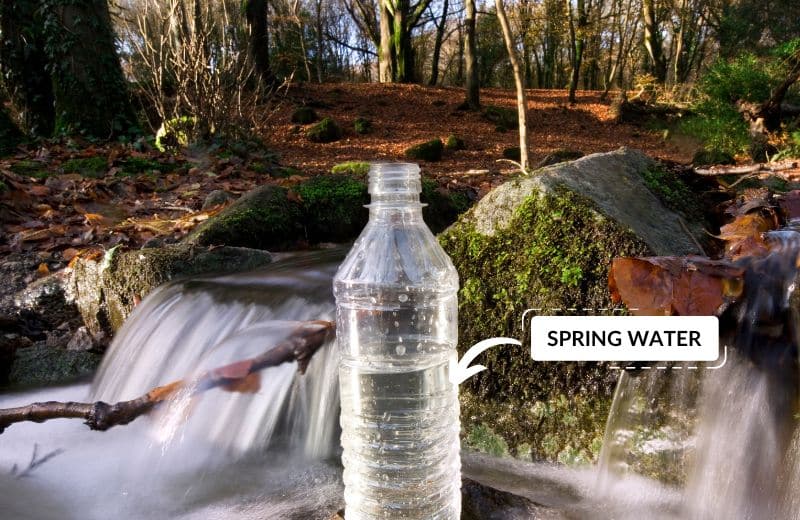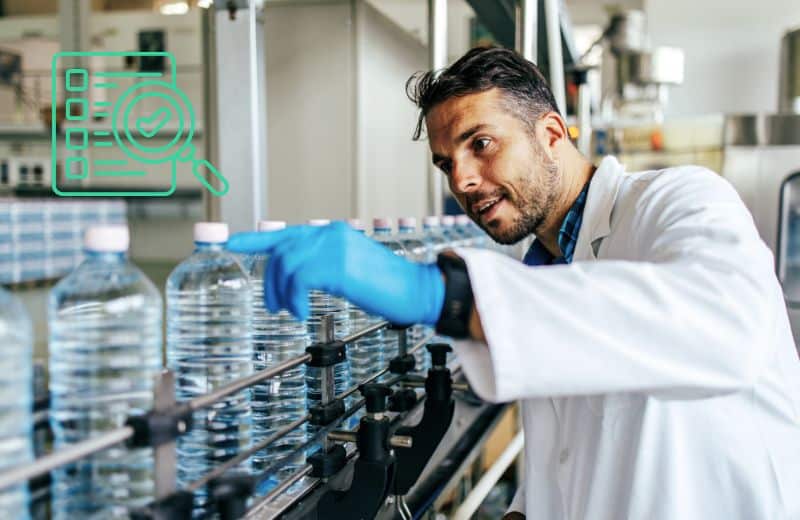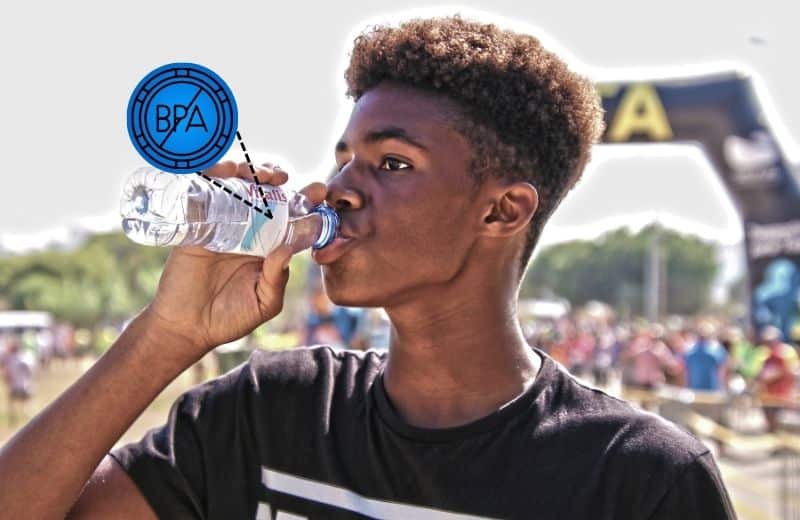Some people are self-proclaimed bottled water snobs, happy to admit that they’re loyal to an expensive bottled water brand because of the water’s taste or the ingredients it contains.
Most of us, however, pick up whatever bottled water happens to be cheapest at the store – without knowing much about what the water contains at all.
We’re drawn into labels such as ‘pure’, ‘fresh’, and ‘natural’ – but just how pure, fresh and natural are bottled waters really?
In this guide, I’ll be looking in detail at where bottled water comes from. I’ve shared the water sources of the most popular bottled water brands, so you can make a more informed decision the next time you buy water from the store.
Table of Contents
- 🤔 So, Where Does Bottled Water Come From?
- 🔖 Bottled Water Sources by Brand
- ⭐ Popular Brands Of Bottled Water That Are Actually Tap Water
- ✅ FDA Bottled Water Safety Regulations
- 🏷️ Bottled Water Label Explanation
- 🦠 Are There Contaminants Are In Bottled Water?
- 💭 Are Some Bottled Water Products Safer to Drink Than Others?
🤔 So, Where Does Bottled Water Come From?
There are three most common bottled water sources: municipal tap water, natural springs, and wells.
Municipal Tap Water
Some bottled water is simply branded tap water. However, the tap water will have usually been filtered, purified, or enhanced with minerals or electrolytes to give it a cleaner, more pleasant taste. Many companies use distillation or reverse osmosis to filter tap water.
Related: Is bottled water distilled?
Natural Springs
Water from natural springs is derived from – you guessed it – natural springs, either above-ground surface water sources or below-ground groundwater sources. Bottled spring water from a spring can’t be modified or treated if the brand wants to advertise the product as “bottled water”.

Wells
Well water is extracted from an aquifer deep underground. Well water often contains a higher mineral content than tap water, but water from wells is more at risk of containing contaminants like bacteria, and must be treated before it’s bottled.
Related:
- The best bottled water in 2024
- The water cycle 101
🔖 Bottled Water Sources by Brand
| Brand | Source |
|---|---|
| Aquafin | Tap Water |
| Crystal Geyser | Natural Spring |
| Dasani | Tap Water |
| Deer Park | Natural Spring |
| Essentia | Tap Water |
| Evian | Natural Spring |
| Fiji | Natural Spring |
| Icelandic | Natural Spring |
| JUST | Natural Spring |
| Kirkland | Tap Water |
| LIFEWTR | Tap Water |
| Nestle Pure Life | Tap Water |
| Ozarka | Natural Spring |
| Smartwater | Natural Spring |
| Voss Natural spring | Natural Spring |
⭐ Popular Brands Of Bottled Water That Are Actually Tap Water
Dasani
Dasani bottled water is tap water sourced from all over the US, including California, Minnesota, and Colorado. Dasani water isn’t plain tap water, though – the water is purified using reverse osmosis, and a blend of minerals are added to improve the taste and health properties of the water.
Nestle Pure Life
Nestle Pure Life comes from several sources, including well water and municipal water supplies. This bottled water has been purified and has some pretty interesting marketing – it’s “100% natural water”, “free from sugar”, and “with zero calories”, as you would expect from any type of water.
Aquafina
Aquafina bottled water is collected from more than 40 water supplies across Canada and the UK. The drinking water is then purified using reverse osmosis, which, according to Aquafina, is so thorough that it “exceeds the purity standards set by the federal government”. This should make Aquafina water safer than tap water, even if that’s where the water comes from.
Smartwater
Smartwater, owned by the Coca-Cola Company, is another filtered tap water product offered in the bottled water industry. Smartwater is vapor distilled, which removes the majority of contaminants. It is then enhanced by vitamins and electrolytes, giving it a pleasant taste that the company says is “crisp” and “clear”.
LIFEWTR
LIFEWTR comes from the same place as our tap water supply – municipal reservoirs. However, LIFEWTR goes through a more extensive treatment process than tap water, improving water quality with reverse osmosis purification and the addition of magnesium sulfate and potassium bicarbonate.
Kirkland
Kirkland water is sourced from a different bottled water company – Niagara Bottling LLC. This company sources its water from a combination of springs, tap water, and local water wells. There’s a good chance that most of the water that ends up in Kirkland’s bottles is tap water. Kirkland adds minerals to enhance the taste of its bottled water.
Continue Reading:
✅ FDA Bottled Water Safety Regulations
While tap water is regulated by the environmental protection agency, bottled water is regulated by the U.S. Food and Drug Administration, or the FDA. Bottled water federal quality standards were introduced in the early 1970s, based on the standards for drinking water set by the U.S. Public Health Service in the early 1960s.
Bottled water companies must adhere to the FDA’s Current Good Manufacturing Practices (CGMPs), which requires them to:
- Process their products (including holding and transportation) in sanitary conditions
- Prevent chemical or bacteriological contamination by using quality control processes
- Test the source water and the final product to ensure safe drinking water with no health-harmful contaminants

Bottled water processing plants and products are monitored closely by the FDA. Monitoring includes inspections of these plants, where the FDA will assess sanitizing and washing procedures, confirm that the bottled water comes from an approved source, inspect the bottling process, and determine the safety of the water quality.
Some states also have their own rules for manufacturers, such as annual licensing.
Related: Unveiling the Life Cycle of Plastic Water Bottles
🏷️ Bottled Water Label Explanation
The FDA mandates that bottled water products are labeled with one of the following:
- Bottled Water – Water in a bottle, source unclear
- Drinking Water – Water that’s safe to drink, source unclear
- Artesian Water – Water collected from a well aquifer
- Mineral Water – Water that comes from underground sources and has a naturally high mineral content (at least 250 ppm of mineral ions)
- Sparkling Bottled Water – Bottled water that has been carbonated, source unclear
- Spring Water – Water that comes from above-ground or underground natural springs
- Purified Water
- Distilled – Water that has been purified using distillation (usually tap water). In distillation, water is vaporized, leaving contaminants behind in the boiling chamber, and condensed back into water
- Demineralized – Water that has had its minerals removed
- Deionized – Water that has had its ions removed
- Reverse Osmosis – Water that has been purified using reverse osmosis (usually tap water). In reverse osmosis, water is forced through a semi-permeable membrane to remove harmful impurities
🦠 Are There Contaminants Are In Bottled Water?
According to the FDA’s regulations, bottled water should be contaminant-free.
All water bottle companies must ensure that their products contain low (or no) microbial, physical, chemical, or radiological impurities. This suggests that bottled water is safer than tap water.
However, it isn’t clear exactly what classifies as contaminant-free. Trace amounts of contaminants may still be present in bottled drinking water, depending on the method of filtration or purification used by the company.
Finding out exactly what a bottle of water contains can be difficult, too – it’s not like trace contaminants are listed on the product label.
Additionally, plastic bottles leach microplastics and dangerous chemicals into water. One test found that nearly all major bottled water brands contained tiny plastic particles.
Aside from the environmental impact of plastic bottles, single-use plastics contaminate most bottled waters.
BPA, BPS, and BPF are other contaminants that leach from plastic bottle products into water. Some brands use BPA-free bottles for safety – you can find out more about BPA-free bottled water brands here.

💭 Are Some Bottled Water Products Safer to Drink Than Others?
Not all bottled water companies use the same sources, and not all companies use the same method of treatment. This means that some bottled water is safer to drink than others.
The safest bottled water is anything that has been purified using distillation or reverse osmosis.
But most water that has been treated this way started off as regular tap water – which means you could easily save money by purifying your own tap water at home.
If you’re concerned about your health, drinking bottled water usually isn’t the answer.
Municipal water is regulated by the EPA, and it isn’t stored in plastic, which means it’s far less likely to contain microplastics or BPA chemicals. Filtering your municipal water will give you the safest drinking water.
